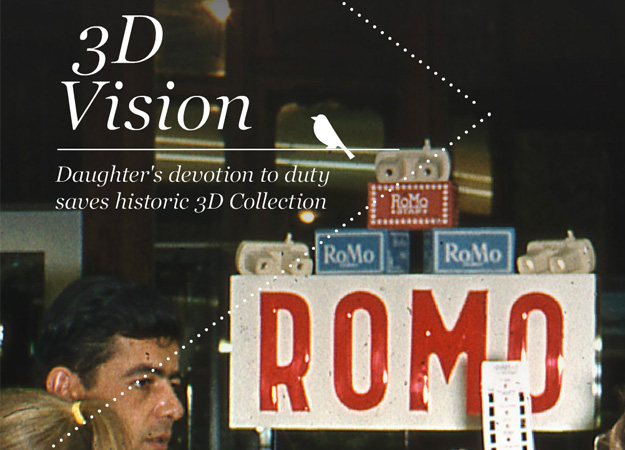
Lark Life, a UK award Winning Insurance Broker, published in its magazine circulated to its private clients an article on ‘3D Vision – Daughter’s devotion to duty saves historic 3D Collection’.
Through a mutual friend in Los Angeles, Betty Thayer was introduced to the 3D team at Sony Pictures and visited with Mr Bob Bailey (Senior Vice President) and Mr Buzz Hays (Director of 3D) in 2013. After numerous conversations Elizabeth Mouzillat Jowett was invited by Buzz Hays to an invitation-only 3D Summit at the British Film Institute in London, at which he was speaking at.
We were pleased to discover after supplying a number of sample images of the Collection, that Buzz based a large amount of time in his talk about RoMo and urged that the audience should take the opportunity to attend the exhibition at the Holburne Museum in Bath.
Mr Hays now runs his own company, is the founding Chairman of the International 3D Society, Lead Instructor of the UT3D program at University of Texas at Austin, Texas and Senior Lecturer at the Moody College of Communication.
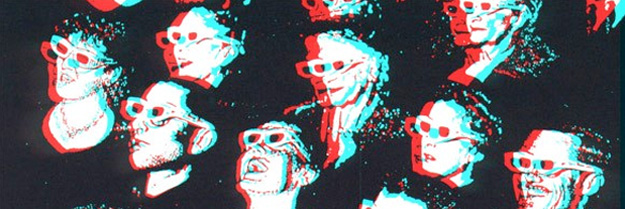
On 11 March 2014 a talk was given during the Exhibition by David G Burder, introduced by Dr. Michael Pritchard (Director General of the Royal Photographic Society), entitled ‘Artists in 3D’ where the RoMo Collection featured prominently as part of the talk.
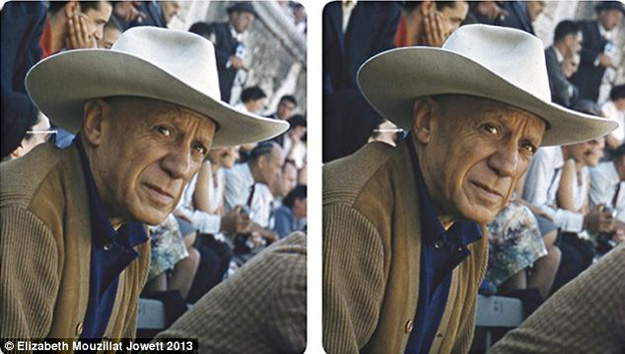
At about the same time the Daily Mail newspaper published an article entitled ‘Picasso Brought Back to Life: 3D Photos of Legendary Artist’ about the exhibition at the Holburne Museum and also referenced the Collection.
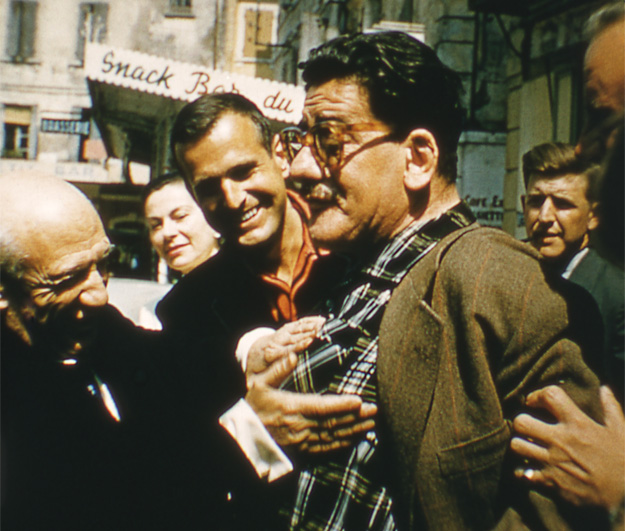
In the 1980s the world-renowned Art Historian, Sir John Richardson was introduced to Robert Mouzillat by the then Chairman of Sotheby’s New York. He proposed to Sir John Richardson to visit Robert Mouzillat at his home in Paris because Sir John Richardson was preparing the next volume of the authorised biography of Picasso. At that meeting Richardson saw the 3D images for the first time, of himself with Picasso together with the filmmaker Jean Cocteau and other well known personalities of the period.
Elizabeth Mouzillat Jowett, through her father, was in communication with Sir John Richardson over the intervening years. On a visit to New York in September 2011 John Richardson invited Elizabeth Mouzillat Jowett and Betty Thayer to tea at his home to talk about mutual experiences of living in Provence in the 1950s, the RoMo Image Library and particularly the Picasso images.
John Richardson was delighted to accept a copy of the photograph of himself with Picasso and the surrealist painter Oscar Dominguez and most kindly offered to help RoMo in any way he could. This resulted in Sir John Richardson writing The Forward to the Exhibition Catalogue ‘Stereoscopic Photographs of Picasso’ held at The Holburne Museum, Bath.
One of the exhibited images shows Sir John Richardson together with Robert Mouzillat and Jean Cocteau and other close friends of Picasso.
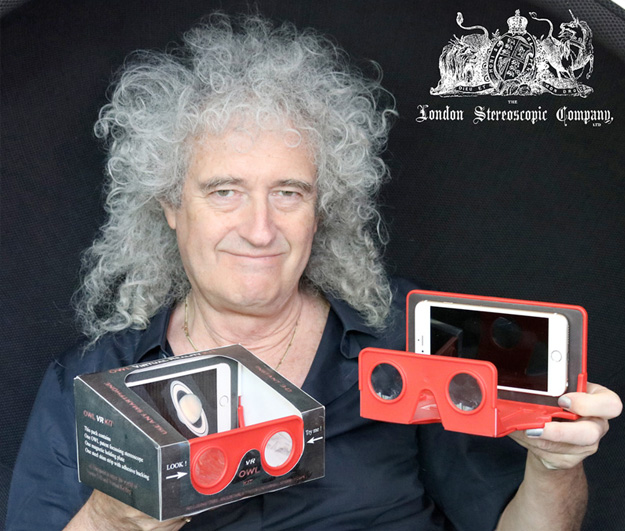
We were kindly assisted in the preparation of images for this exhibition by the invaluable participation of Dr. Brian May, proprietor of The London Stereoscopic Company, and his colleague Denis Pellerin.
We were introduced to Dr Brian May by mutual friends in 2011 and corresponded as to the future of the Image Library. We were later invited by The Holburne Museum, Bath to exhibit ‘Stereoscopic Photographs of Picasso’ and the images were selected by Dr Alexander Sturgis.
During this time a contact of Dr Sturgis mentioned that he published Brian May’s books and suggested Dr May may be interested in the project, due to his lifelong interest in vintage stereoscopic images. We were delighted and appreciative that Dr May volunteered to participate and spent many hours in the preparation of the images so they could be viewed in 3D on screens at the exhibition, and in the catalogue through The London Stereoscopic Company’s Owl viewer.
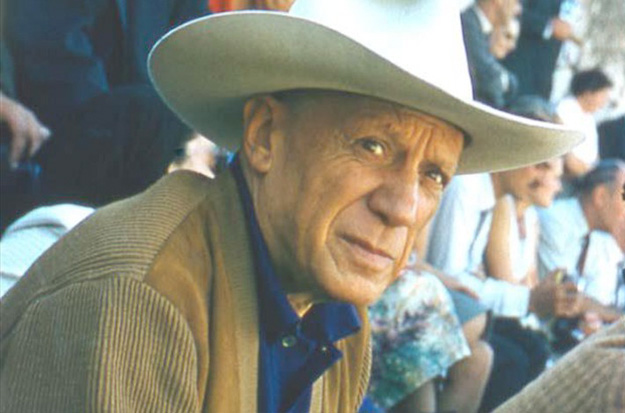
In 2013 the Director of The Holburne Museum, Bath, Dr Alexander Sturgis (appointed Director, University of Oxford’s Ashmolean Museum, October 2014) was approached by Mrs Thayer, a patron of the Museum, to explore the possibility of holding an exhibition at the Museum of a part of the collection of Picasso images showing them on modern 3D screens and viewed with passive 3D glasses.
Dr Sturgis visited Jersey to view the 200 images that were taken in 1957 and made his selection, which included Picasso in his studio and garden of his home La Californie, the Easter bullfight and celebrations amongst his friends in Arles. This group of friends included Sir John Richardson (art historian and official biographer of Picasso), Jaime Sabartès, Jean Cocteau and surrealist artist, Oscar Dominguez. It was the weekend of one of the great bullfights or corridas in Arles, which were among the few events that lured Picasso from the grounds of his home La Californie. In contrast to almost all other photographs of Picasso taken at this time, they are in colour and even more remarkably they are in 3D. These images that would be shown at the exhibition have not been exhibited or seen outside of the Collection before.
In addition to the exhibition a booklet was prepared that features many of the photos included in the exhibition. Dr Brian May was instrumental in preparing the images and providing the appropriate viewer for the booklet.
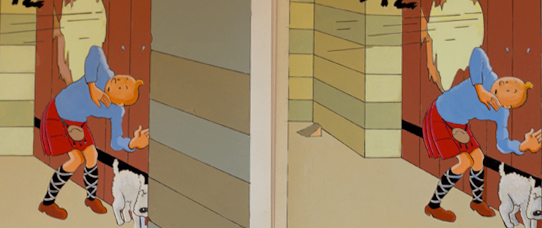
With the production of the stereocards of “Les Aventures de Tintin” it is believed that RoMo was the first company to produce Tintin bandes dessinées in combined colour and stereoscopic format.
In 1957 RoMo contacted Casterman, the publishers of Hergé’s Tintin, to discuss implementation of a series of stereocards, the subject being “Les Aventures de Tintin”. The two companies came to a rapid agreement: RoMo would produce and distribute the stereocards of a Tintin adventure as a set of 12 stereoscopic drawings, using the RoMo stereocard format.
At the start, RoMo would produce a series based on “Tintin in the Congo”, the second of Hergé’s Tintin series. The projects had to be approved with the agreement of Hergé, as did the choice of the various selected images to be used.
In May 1957 RoMo received at its Paris office a file of 4 pages of proposals for 25 stereocards to be developed between RoMo and Hergé’s team. All the images produced were to be approved by Hergé and the choice of the images were to be made by Studio Hergé.
The first set of stereocards were:
The above series were to be the only stereocards cards created.
The artist working with RoMo encountered several problems with the frames proposed and Hergé himself didn’t find the examples proposed particularly convincing. The drawings weren’t done by Hergé himself but his team used the scenes from the books to serve as inspiration for these stereo images. Colour was added to create the 3D effect because the RoMo camera looked through the line drawings, which is believed to to be first time Hergé’s work was coloured for commercial purposes. These drawings weren’t to Hergé’s taste as they weren’t in ‘la ligne claire‘ for which his work is known.
At Christmas time 1957, after many reworking of the images to get the 3D effect working without losing the clarity of Hergé’s artwork, 3 of the images from this series were finished and made available for public purchase, and the other four series were produced and sold in Autumn 1958.
A further 5 Tintin series that the Studio Hergé wished RoMo to make were never realised.
It is estimated that the collaboration between RoMo and Casterman ended in 1960.
The Collection currently holds 202 gouache artworks of the ‘left and right eye’ images that were drawn and painted to be used to create the stereoscopic images, as well as 176 original master positive film images that were used to create the stereocards.

We were advised that the images should be digitised. That it was preferable to do so in-house rather than instructing an outside company. A great personal friend of Elizabeth Mouzillat Jowett is Professor Dr. Michael Forsyth (Director of Studies, Department of Architecture & Civil Engineering at University of Bath) suggested and put us in touch with the Professor Stephen Gray at the Institute for Learning and Research Technology, University of Bristol, the foremost centre of digitisation technology in the UK.
We arranged a meeting with Professor Gray which was attended by his assistants and students. He and his students viewed the sample originals images we had brought with us on their equipment and returned to the meeting hugely enthusiastic and amazed at the clarity and quality of the images. He decided at the meeting he would work with his staff and students on the project of digitisation of the RoMo Image Library and prepare a report and advisory document that we received in August 2012.
Following the report “RoMo Stereo Pair Digitisation” by Professor Stephen Gray of the Institute for Learning and Research Technology, University of Bristol, we implemented the recommendations and setup digitisation equipment and process for in-house viewing and to aid the cataloguing work being done.
Professor Gray came to Jersey to meet with Robbie Andrews and Catherine Kirby and verify that the setup and process would maintain the quality and standards that he had advised. RoMo was now able to digitise the images in-house and thus keep control of the intellectual property.
There were negotiations in 1964 between representatives of Robert Mouzillat and the Eastman Kodak Company intended to lead to the acquisition of the patent rights to the 3D camera by the Eastman Kodak Company of Rochester, New York. Following meetings and correspondence between the parties a satisfactory outcome could not be reached.
However the matter was revived some years later. In a letter of 2 June 1992 the then Commercial Director of Kodak Pathe concluded that: “I have never seen such images that, moreover after 40 years in storage, maintain their quality of origin, definition and colours”